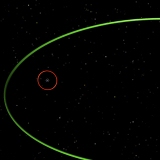 Voyager 2 image of Nereid. |
|
| NEREID - MOON OF NEPTUNE | |
| Nereid is any one of 50 to 100 water nymphs, the daughters of Nereus and Doris. The Nereid's inhabit either salt or fresh water. They are depicted as young girls and are well-disposed towards humans. Nereid was discovered in 1949 in photographs by Gerard Kuiper. | |
| Orbit | |
| Nereid is the outermost Neptunian satellite. Its distance from Neptune varies between 1,353,600 and 9,623,700 kilometres, making its orbit the most eccentric (0.7512) orbit of any moon or planet in the Solar System. Nereid's orbit also has a high inclination to Neptune's equator - 27.6o . This may be because it is a captured asteroid. It has also been suggested that it was set on its elongated orbit when Triton was incorporated into the Neptunian system. | |
 The orbits of Nereid and Triton. |
|
| Physical properties | |
| Nereid is Neptune's third largest moon, 340 kilometres across. Nereid's mass is unknown, and hence the density is also unknown. | |
| Interior | |
| The interior and composition of Nereid is unknown. | |
| Magnetic field | |
| No magnetic field has been detected. | |
| Atmosphere | |
| No atmosphere has been detected. | |
| Surface | |
| The surface of Nereid is brighter (albedo 0.2) than all the inner satellites except Triton. The best Voyager pictures were obtained at a distance of 4.7 million kilometres, and show Nereid at a resolution of only 43 kilometres per pixel. | |
| They show that is an irregular-shaped object with a rugged surface, but little else can be determined. The brighter surface of Nereid (it is brighter than the other small moons of Neptune) suggests it may have a surface of water frost, mixed in with a darker, unknown material. Nereid's surface properties are similar to one of Saturn's outer moons, Phoebe. As Phoebe, like Nereid, also has an inclined orbit, both bodies at first sight look like having originated as asteroids. | |
| However, Nereid does not have a retrograde orbit, and its surface darkness does not match those of asteroids. Nereid may not be captured - it could be an original moon of Neptune, and is only now in an unusual orbit because of Triton's interference. | |
|
|
|